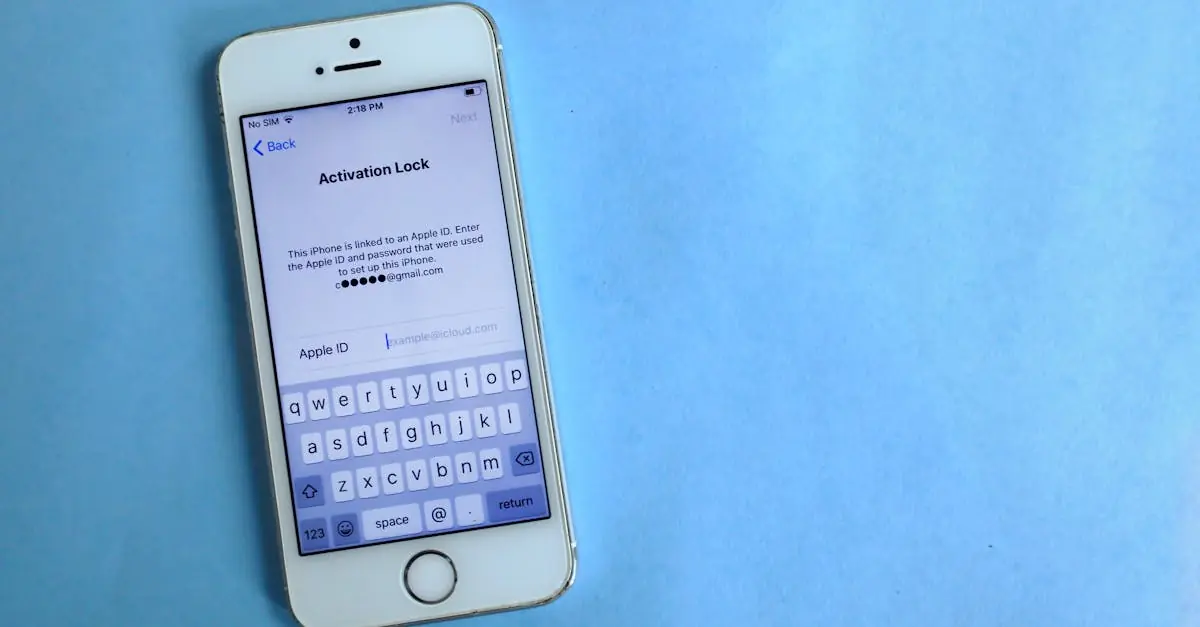Lost your Apple ID password? You’re not alone. It’s like misplacing your keys, but instead of being late to work, you’re locked out of your digital life. Panic not! Your iPhone is more than just a sleek device; it’s also your trusty sidekick in the quest to retrieve that elusive password.
Table of Contents
ToggleUnderstanding Apple ID Password
An Apple ID password is essential for accessing various Apple services. It secures personal information and allows users to enjoy the full range of features available on their devices.
Importance of Apple ID
Apple ID serves as a unique identifier for Apple services and devices. Managing purchases across iTunes and the App Store depends on this account. Families can also share subscriptions and purchases, enhancing connectivity. Security features like two-factor authentication rely on the Apple ID, giving additional protection to personal data. Moreover, iCloud storage requires an Apple ID for syncing and backup purposes, ensuring files are accessible from any device.
Common Issues Related to Passwords
Many users encounter issues when trying to remember their Apple ID password. Forgetting this password can block access to apps, music, or documents, causing frustration. Users often experience login errors or face challenges when using payment methods. Account security questions can also complicate matters if forgotten. Additionally, password reuse across different services may lead to vulnerabilities, putting accounts at risk. Regularly updating passwords improves security and minimizes these issues.
Finding Your Apple ID Password on iPhone
Finding an Apple ID password on an iPhone can simplify access to Apple services. Several methods exist to retrieve or reset this essential information.
Using Settings to Retrieve Your Password
Settings can offer a straightforward way to find the Apple ID password. Users tap on their name at the top of the Settings menu, then select “Password & Security.” From there, they can choose “Change Password” to see if any saved passwords are available. Apple may prompt verification through Face ID or Touch ID. This method provides quick access when the password is stored in iCloud Keychain.
Resetting Your Apple ID Password
Resetting the Apple ID password becomes necessary when access remains blocked. Users navigate to the Settings menu, tap on their name, then select “Password & Security.” The “Change Password” option appears. After entering the current password, users can create a new one. If they forgot the previous password, tapping “Forgot Apple ID or password?” leads to guided steps for recovery via email or security questions. This method restores access and continues the seamless use of Apple services.
Additional Methods to Access Your Password
Exploring alternative methods can help users access their Apple ID password more easily. Here are a couple of options to consider.
Using iCloud Keychain
iCloud Keychain securely stores passwords on Apple devices. Users can access their stored Apple ID password through this feature. To do this, they must open Settings, tap on their name, then select iCloud and Keychain. After enabling Keychain, users can navigate to Settings again. Accessing “Passwords” allows them to view saved passwords. Once they find their Apple ID entry, users can view the password by selecting it and authenticating with Face ID or Touch ID.
Using the Apple Support App
The Apple Support app provides assistance with Apple ID password recovery. Users can download and open the app to find helpful resources. After signing in, selecting the “Get Support” option leads them to various topics. Choosing “Apple ID” and following prompts can help address password issues. Support articles outline steps to reset Apple ID passwords and provide guidance through recovery processes. Engaging with Apple Support can lead to effective resolutions and restore access to accounts quickly.
Tips for Managing Your Apple ID Password
Managing an Apple ID password effectively ensures account security. Simple strategies exist to enhance password strength and protect sensitive information.
Creating a Strong Password
Create passwords that combine letters, numbers, and symbols for optimal strength. Aim for at least 12 characters to prevent unauthorized access. Avoid using easily obtainable information like birthdays or names. Incorporate unique phrases that are memorable but difficult to guess. It’s beneficial to rotate passwords periodically to further enhance security. Using a password manager helps generate complex passwords, eliminating concerns about memorizing each one.
Keeping Your Password Secure
Secure your password by enabling two-factor authentication. This adds an extra layer of protection against unauthorized access. Store passwords in a password manager instead of writing them down. Sharing passwords can expose sensitive information, so it’s advisable to refrain from doing so. Regularly update passwords to prevent possible breaches. Be cautious when logging into accounts on public Wi-Fi networks, as they can be susceptible to security risks.
Finding an Apple ID password on an iPhone doesn’t have to be a daunting task. With the right steps and tools at hand users can regain access to their accounts swiftly. By utilizing features like iCloud Keychain and the Settings menu users can simplify the process of password recovery.
It’s crucial to prioritize account security by creating strong passwords and enabling two-factor authentication. Regularly updating passwords and avoiding reuse across different services can significantly enhance security. With these practices in place users can navigate their Apple ecosystem confidently and securely.




